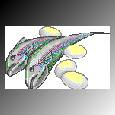|
Enteritis accounts for most cases of food poisoning in the United States; it includes a broad group of diseases caused by:
- Salmonella enteritidis: 40,000 cases/year; from milk, poultry, and eggs. The bacteria can be inside perfectly normal-appearing eggs, and if the eggs are eaten raw or undercooked, the bacterium can cause illness. It usually causes fever, abdominal cramps, and diarrhea within 12 to 72 hours after consuming a contaminated food or beverage. The illness usually lasts 4 to 7 days, and most persons recover without antibiotic treatment. However, the diarrhea can be severe, and the person may be ill enough to require hospitalization.
- Escherichia coli: millions of cases/year; from contaminated food and water. E. coli is an important cause of bacterial diarrheal illness; it is the leading cause of travelers' diarrhea and a major cause of diarrheal disease in underdeveloped nations. It is transmitted by food or water contaminated with animal or human feces. The infection often ends on its own and is rarely life-threatening, although fluid replacement may be needed.
- Bacillus cereus: hundreds of cases/year; from contaminated rice and potatoes. The diarrheal type of Bacillus poisoning causes watery diarrhea, abdominal cramps, and pain within 6-15 hours after consuming contaminated food; symptoms persist for 24 hours. The vomiting (emetic) type of Bacillus poisoning causes nausea and vomiting within 0.5 to 6 hrs after consuming contaminated foods; symptoms persist less than 24 hrs.
- Clostridium perfringens: hundreds of cases/year; from contaminated meat. The bacteria multiply in undercooked food as it cools, and cause intense abdominal cramps and diarrhea within 8-22 hours. Large numbers of bacteria must be present to release a toxin that causes the disease, which is over within 24 hours.
- Campylobacter jejuni: causes 5-11% of diarrheal diseases; from contaminated food and water. Campylobacteriosis causes diarrhea (sometimes bloody), cramping, abdominal pain (sometimes nausea and vomiting), and fever within 2 to 5 days after exposure; the illness typically lasts for 1 week.
- Rotavirus: 870,000 cases/year. Rotaviruses causes vomiting, watery diarrhea, and low-grade fever, although someone can be infected and not show symptoms, but still spread the disease. Infection can be readily acquired through contaminated food (uncooked), hands, objects, or utensils.
- Echovirus: millions of cases/year; from contaminated water. Echoviruses can be found in improperly prepared food or contaminated water and can cause diarrhea, abdominal cramping, nausea, and vomiting.
How It Affects the Body (Pathogenesis):
All of these diseases cause an inflammation of the small intestine, which causes water and electrolytes to flow from cells in the bloodstream to the small intestine, where they are flushed out of the body by peristalsis, resulting in diarrhea. Fortunately, this often flushes the pathogens out of the body, so the immune system can take control once again. These diseases often take 2-3 days to show up, so when trying to determine the cause of the illness, it is important to remember what has been consumed/contacted in the past 2-3 days, not the past few hours. It is also important to replenish lost fluids and electrolytes so dehydration does not occur.
|



![]()